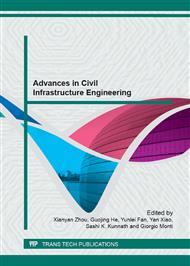p.906
p.911
p.917
p.925
p.930
p.935
p.939
p.943
p.947
In Situ Experimental Study of Environmental Vibration Induced by CRH on Elevated Railway Station
Abstract:
On the basis of testing the environmental vibration of the different regions of the elevated station, this paper analyzed the experimental data by the time domain, the vibration acceleration level and spectrum, and some meaningful conclusions are obtained. The vertical Z weighted vibration acceleration level of the office and waiting room achieve 80.7dB, 78.8dB, indicating a serious vibration problem about elevated station, and that some more attention should be paid. Office has an equivalent transverse and longitudinal vibration level; the vertical vibration of the office is slightly larger than the waiting room, but the lateral vibration of the office is obviously lower than the waiting room. The exposure time of the vertical vibration is longer than the horizontal vibration in the same location, and a phase difference exists between them. Lateral vibration of the first floor of the station holds a longer exposure time than the box girder, and has lagged far behind in the box girder. The vertical vibration attenuated slower than the horizontal vibration. The high-frequency vibration is attenuated in the propagation from the box girder to the station floor, while the proportion of low-frequency vibration is improved.
Info:
Periodical:
Pages:
930-934
Citation:
Online since:
January 2013
Authors:
Price:
Сopyright:
© 2013 Trans Tech Publications Ltd. All Rights Reserved
Share:
Citation:


